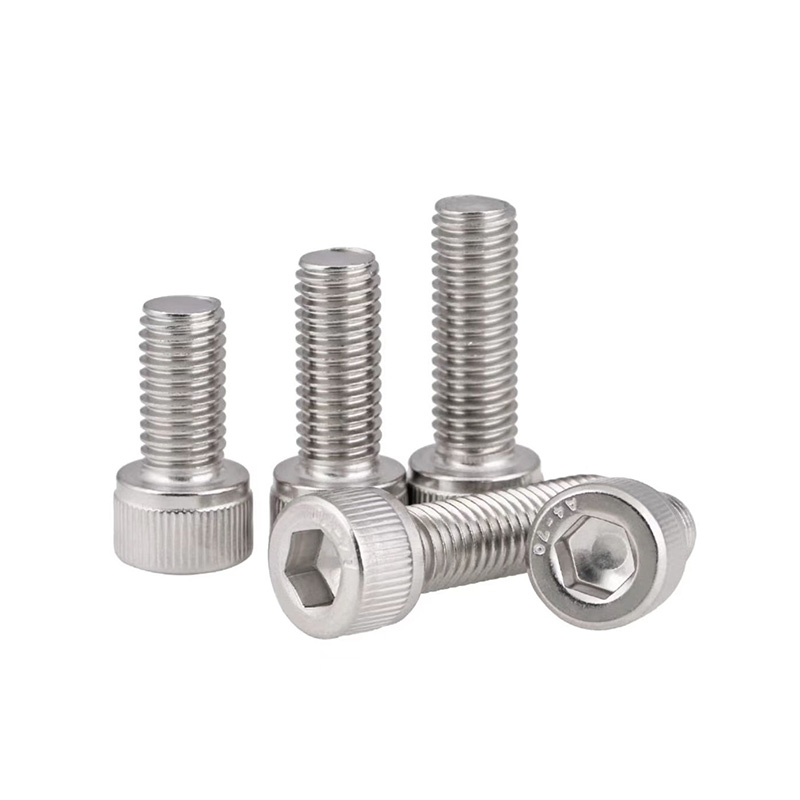Content
Metallurgical Foundations of Stainless Steel Fasteners
1. Alloy Classifications and Key Grades
Stainless steel fasteners are categorized by their crystalline structures and alloy compositions:
-
Austenitic (300 Series):
-
AISI 304 (1.4301): 18% Cr, 8% Ni; general-purpose use with moderate chloride resistance.
-
AISI 316 (1.4401): 16–18% Cr, 10–14% Ni, 2–3% Mo; superior pitting resistance for marine applications.
-
-
Martensitic (400 Series):
-
AISI 410 (1.4006): 12% Cr, 1% C; heat-treatable for high-strength bolts (up to 1,500 MPa UTS).
-
-
Duplex (e.g., 2205):
-
22% Cr, 5% Ni, 3% Mo; combines austenitic toughness with ferritic stress corrosion cracking (SCC) resistance.
-
2. Corrosion Resistance Mechanisms
-
Passive Layer Formation: Chromium oxide (Cr₂O₃) film (3–5 nm thick) self-repairs in oxygenated environments.
-
Pitting Resistance Equivalent Number (PREN):
Higher PREN (>35) indicates resistance to chloride-induced corrosion.
3. Mechanical Properties
| Grade | Yield Strength (MPa) | Tensile Strength (MPa) | Elongation (%) |
|---|---|---|---|
| 304 | 215 | 505 | 40 |
| 316 | 240 | 515 | 40 |
| 410 | 950 (QT) | 1,200 (QT) | 12 |
| 2205 | 450 | 620 | 25 |
Advanced Manufacturing Processes
1. Cold Forging and Thread Rolling
-
Cold Heading: High-speed formers (200–400 strokes/min) shape wire into blanks with minimal material waste.
-
Thread Rolling: Produces threads with 20% higher fatigue strength vs. cut threads due to compressive residual stresses.
2. Heat Treatment
-
Solution Annealing (Austenitic): 1,010–1,120°C quench to dissolve carbides and restore corrosion resistance.
-
Quench & Temper (Martensitic): Oil quenching at 980°C followed by 600°C tempering for hardness control (28–32 HRC).
3. Surface Treatments
-
Passivation: Nitric acid bath (20–50% v/v) removes iron contaminants, enhancing Cr₂O₃ layer integrity.
-
Electropolishing: Micro-smoothing (Ra <0.1 μm) reduces bacterial adhesion in food/pharma applications.
-
PVD Coatings: TiN or CrN layers (3–5 μm) improve wear resistance in high-cycle applications.
Industrial Applications and Performance Criteria
1. Marine and Offshore Engineering
-
Grade 316L Fasteners: PREN 26–33 withstands salt spray (ASTM B117) for 1,000+ hours without red rust.
-
Super Duplex Bolts (e.g., UNS S32750): PREN >40 for subsea oil rigs with H₂S exposure.
2. Chemical Processing
-
Alloy 20 (UNS N08020): 20% Cr, 35% Ni, 3.5% Cu; resists sulfuric acid at elevated temperatures.
-
PTFE-Coated Nuts: Prevent galling in aggressive media (pH <2).
3. Automotive and Aerospace
-
A286 (660 MPa): Precipitation-hardened austenitic alloy for exhaust manifold studs (800°C cyclic tolerance).
-
Lockbolt Systems: Monobolt® pins with 12.9-grade strength for airframe assemblies.
4. Renewable Energy
-
Wind Turbine Flange Bolts (ASTM A320 L7): Charpy impact tested at -150°C for Arctic installations.
Technical Challenges and Mitigation Strategies
1. Galling and Cold Welding
-
Cause: Frictional heat during tightening (≥0.5 μm surface roughness).
-
Solutions:
-
Molybdenum disulfide (MoS₂) coatings.
-
Asymmetric thread forms (e.g., Spiralock®).
-
2. Stress Corrosion Cracking (SCC)
-
Risk Factors: Cl⁻ concentration >10 ppm, tensile stress >50% yield.
-
Prevention:
-
Use duplex or super austenitic (6% Mo) grades.
-
Apply shot peening to induce compressive surface stresses.

-
3. Hydrogen Embrittlement
-
Vulnerable Grades: High-strength martensitic (≥1,200 MPa).
-
Countermeasures:
-
Baking at 190–230°C for 24 hours post-plating.
-
Low-hydrogen electroplating processes (e.g., zinc-nickel).
-
Innovations and Market Trends
1. Additive Manufacturing
-
3D-Printed Custom Fasteners: Laser powder bed fusion (LPBF) of 17-4 PH stainless for complex geometries.
-
Topology-Optimized Designs: Weight reduction up to 40% without compromising strength.
2. Smart Fasteners
-
Embedded Sensors: Strain gauges in bolts for real-time load monitoring (IoT-enabled predictive maintenance).
-
RFID Tagging: Track fastener lifecycle in critical infrastructure projects.
3. Sustainable Production
-
Recycled Stainless Steel: 80% lower carbon footprint using scrap-based melts (e.g., Outokumpu CircleGreen®).
-
Biodegradable Lubricants: Plant-based threading compounds meeting NSF H1 standards.
4. Global Market Dynamics
-
Growth Projection: 4.8% CAGR (2023–2030), driven by offshore wind and EV sectors.
-
Regional Demand: Asia-Pacific dominates with 45% market share (China, India infrastructure expansion).

 English
English 中文简体
中文简体 Español
Español русский
русский عربى
عربى








